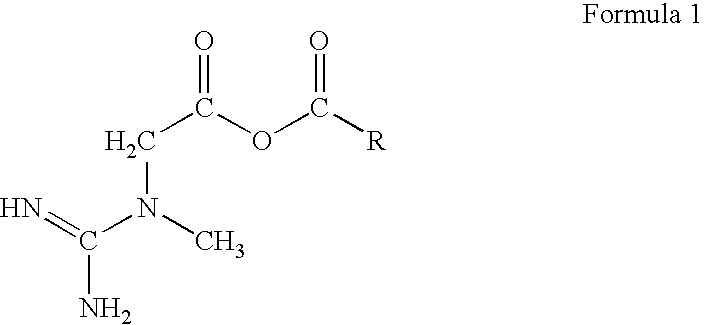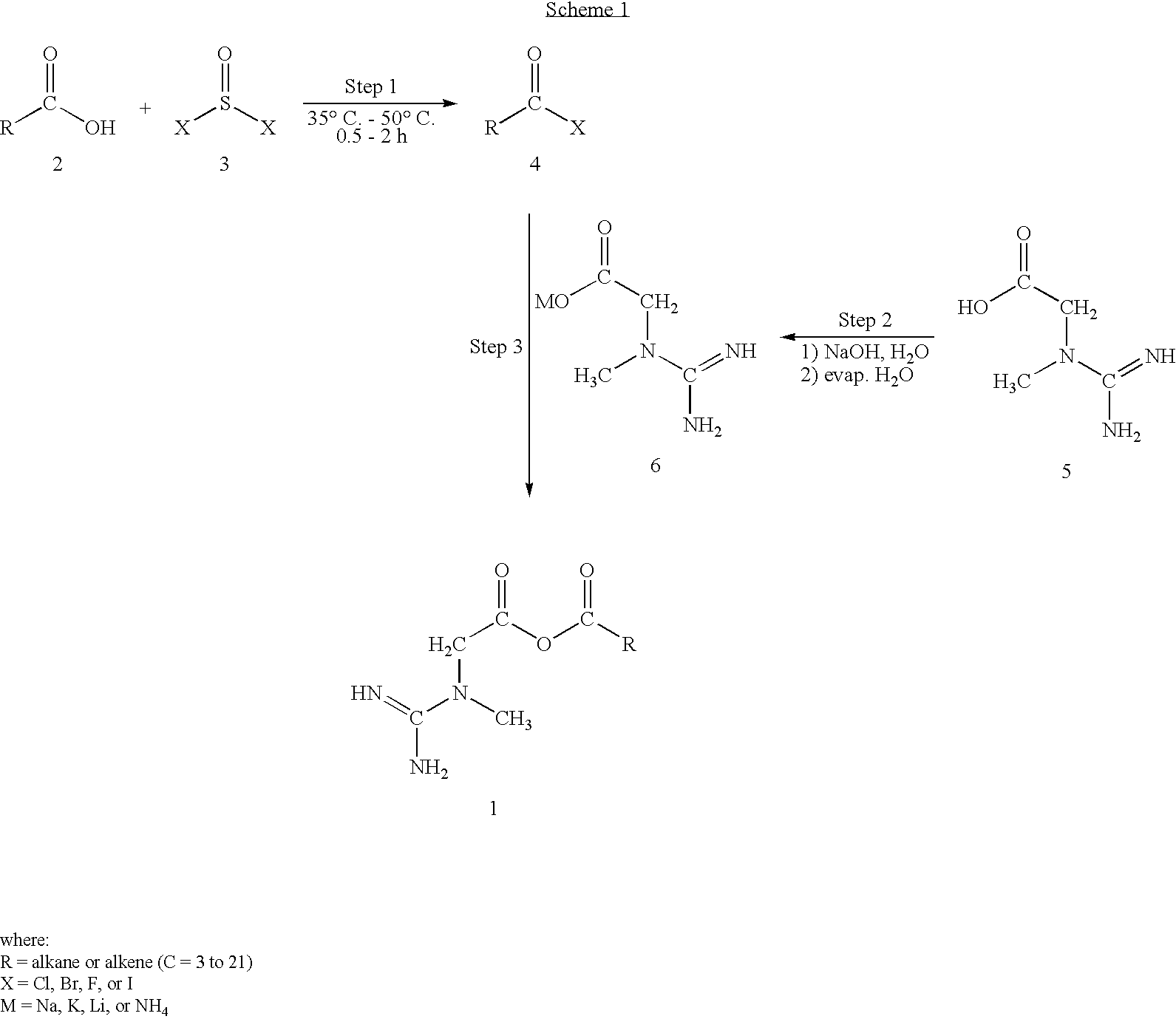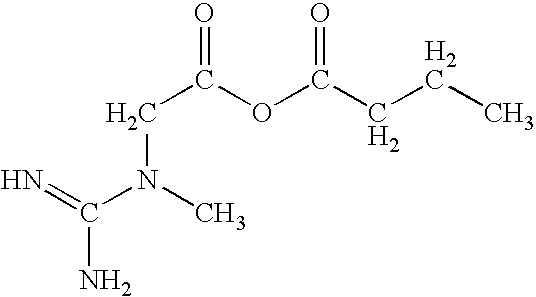Creatine-fatty acids
a technology of creatine and fatty acids, which is applied in the field of structure and synthesis of creatinefatty acid compounds, can solve the problems of limiting the conversion of creatine to creatine, requiring large amounts of water to be co-ingested, and unrealistic to significantly increase the creatine stores of muscle cells through merely food sources alon
- Summary
- Abstract
- Description
- Claims
- Application Information
AI Technical Summary
Problems solved by technology
Method used
Image
Examples
example 1
Butyric 2-(1-methylguanidino)acetic anhydride
[0045]
[0046]In a dry 2-necked, round bottomed flask, equipped with a magnetic stirrer and fixed with a separatory funnel, containing 8.75 ml (120 mmol) of thionyl chloride, and a water condenser, is placed 9.05 ml (100 mmol) of butanoic acid. Addition of the thionyl chloride is completed with heating to about 40° C. over the course of about 30 minutes. When addition of the thionyl chloride is complete the mixture is heated and stirred for an additional 30 minutes. The water condenser is then replaced with a distillation side arm condenser and the crude mixture is distilled. The crude distillate in the receiving flask is then fractionally distilled to obtain the acyl chloride, butyryl chloride.
[0047]Separately, in a single-necked, round bottomed flask, equipped with a magnetic stirrer, 6.56 g (50 mmol) of creatine is dissolved in 500 ml of water. To this is added 55 ml of 1M sodium hydroxide with vigorous stirring, until heat production ce...
example 2
Hexanoic 2-(1-methylguanidino)acetic anhydride
[0050]
[0051]In a dry 2-necked, round bottomed flask, equipped with a magnetic stirrer and fixed with a separatory funnel, containing 6.97 ml (90 mmol) of thionyl bromide, and a water condenser, is placed 5.68 ml (45 mmol) of hexanoic acid. Addition of the thionyl bromide is completed with heating to about 50° C. over the course of about 50 minutes. When addition of the thionyl bromide is complete the mixture is heated and stirred for an additional hour. The water condenser is then replaced with a distillation side arm condenser and the crude mixture is distilled. The crude distillate in the receiving flask is then fractionally distilled to obtain the acyl bromide, hexanoyl bromide.
[0052]Separately, in a single-necked, round bottomed flask, equipped with a magnetic stirrer, 6.56 g (50 mmol) of creatine is dissolved in 500 ml of water. To this is added 55 ml of 1M sodium hydroxide with vigorous stirring, until heat production ceases. At th...
example 3
Dodecanoic 2-(1-methylguanidino)acetic anhydride
[0055]
[0056]In a dry 2-necked, round bottomed flask, equipped with a magnetic stirrer and fixed with a separatory funnel, containing 5.85 ml (80 mmol) of thionyl chloride, and a water condenser, is placed 10.02 g (50 mmol) of dodecanoic acid. Addition of the thionyl chloride is completed with heating to about 45° C. over the course of about 40 minutes. When addition of the thionyl chloride is complete the mixture is heated and stirred for an additional 50 minutes. The water condenser is then replaced with a distillation side arm condenser and the crude mixture is distilled. The crude distillate in the receiving flask is then fractionally distilled to obtain the acyl chloride, dodecanoyl chloride.
[0057]Separately, in a single-necked, round bottomed flask, equipped with a magnetic stirrer, 7.87 g (60 mmol) of creatine is dissolved in 600 ml of water. To this is added 78 ml of 1M ammonium hydroxide with vigorous stirring, until heat produ...
PUM
| Property | Measurement | Unit |
|---|---|---|
| Structure | aaaaa | aaaaa |
Abstract
Description
Claims
Application Information
 Login to View More
Login to View More - Generate Ideas
- Intellectual Property
- Life Sciences
- Materials
- Tech Scout
- Unparalleled Data Quality
- Higher Quality Content
- 60% Fewer Hallucinations
Browse by: Latest US Patents, China's latest patents, Technical Efficacy Thesaurus, Application Domain, Technology Topic, Popular Technical Reports.
© 2025 PatSnap. All rights reserved.Legal|Privacy policy|Modern Slavery Act Transparency Statement|Sitemap|About US| Contact US: help@patsnap.com



